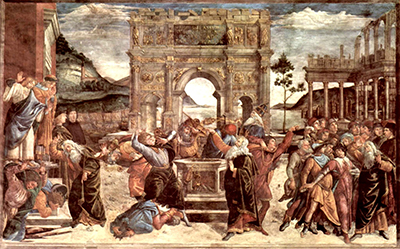Sandro Botticelli would produce a series of paintings which focused on several episodes from the life of Moses. These individual panel artworks would be placed together within the Sistine Chapel in Italy, where they remain today.
Italian art has many examples which focus on the life of Christ, but Moses is less common. Some of the topics that could be included are Moses Leaving for Egypt, The Youth of Moses, The Crossing of the Red Sea, The Descent from Mount Sinai, The Punishment of the Sons of Korah and also the Testament and Death of Moses. Each of Botticelli's panels would be around 5 1/2 metres in width, and around 3 1/2 metres in height with a whole wealth of figures included within landscape scenes. He would also incorporate elements of architecture alongside, meaning many of his mastered genres would be included together within these highly intriguing designs. All of these panels are dated at around the early 1480s and made use of egg tempera on wooden panel which is how Botticelli worked throughout his career - it would only be years later that Italian artists would start to use oils instead.
The artist ran a large studio from which he could call upon the services of a number of respected assistants for some of his larger projects. The detail and size of these panels meant that their help was highly necessary and it allowed Botticelli to complete the commission without too many delays. He would carefully plan out which elements he would handle himself, and then assign less significant parts of each composition to others, whilst always keeping a close eye on their progress in order to ensure that his high standard would be meet consistently. The Renaissance was known for the use of assistants with installed tempera work often making use of huge murals with excessive detail which no individual could realistically accomplish on their own without a huge amount of time at their disposal.
The artist would produce a variety of portraits within his career, including a good number of personal pieces of local Florentine models. He would also work more ambitiously as seen here, with full figures in different combinations. He also mastered landscape art and would incorporate those elements across his backgrounds, adding interest and colour. There would also be architecture too, underlining the breadth of talents mastered by this famous Florentine who eventually would become known as one of the key members of the Early Renaissance which would eventually spread to all of Italy.




